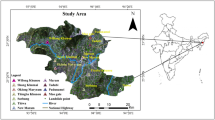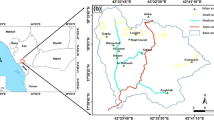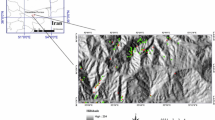Abstract
The main purpose of this study is to compare the use of logistic regression, multi-criteria decision analysis, and a likelihood ratio model to map landslide susceptibility in and around the city of İzmir in western Turkey. Parameters, such as lithology, slope gradient, slope aspect, faults, drainage lines, and roads, were considered. Landslide susceptibility maps were produced using each of the three methods and then compared and validated. Before the modeling and validation, the observed landslides were separated into two groups. The first group was for training, and the other group was for validation steps. The accuracy of models was measured by fitting them to a validation set of observed landslides. For validation process, the area under curvature (AUC) approach was applied. According to the AUC values of 0.810, 0.764, and 0.710 for logistic regression, likelihood ratio, and multi-criteria decision analysis, respectively, logistic regression was determined to be the most accurate method among the other used landslide susceptibility mapping methods. Based on these results, logistic regression and likelihood ratio models can be used to mitigate hazards related to landslides and to aid in land-use planning.








Similar content being viewed by others
References
Akgun A, Bulut F (2007) GIS-based landslide susceptibility for Arsin-Yomra (Trabzon, North Turkey) region. Environ Geol 51:1377–1387
Akgun A, Turk N (2010) Landslide susceptibility mapping for Ayvalik (Western Turkey) and its vicinity by multicriteria decision analysis. Environ Earth Sci 61(3):595–611
Akgun A, Dag S, Bulut F (2008) Landslide susceptibility mapping for a landslide-prone area (Findikli, NE of Turkey) by likelihoodfrequency ratio and weighted linear combination models. Environ Geol 54(6):1127–1143
Akgun A, Sezer EA, Nefeslioglu HA, Gokceoglu C, Pradhan B (2011) An easy-to-use MATLAB program (MamLand) for the assessment of landslide susceptibility using a Mamdani fuzzy algorithm. Comput Geosci. doi:10.1016/j.cageo.2011.04.012
Atkinson PM, Massari R (1998) Generalized linear modelling of susceptibility to landsliding in the central Appennines, Italy. Computers and Geoscience 24(4):373–385
Atkinson PM, Massari R (2011) Autologistic modelling of susceptibility to landsliding in the Central Apennines, Italy. Geomorphology 130:55–64
Avşar M (1997) General assessment of landslides in Izmir metropolitan area. MSc Thesis, Dokuz Eylul University
Ayalew L, Yamagishi H (2005) The application of GIS-based logistic regression for landslide susceptibility mapping in the Kakuda-Yahiko Mountains, Central Japan. Geomorphology 65:15–31
Ayalew L, Yamagishi H, Marui H, Kanno T (2005) Landslide in Sado Island of Japan: part II. GIS-based susceptibility mapping with comparision of results from two methods and verifications. Eng Geol 81:432–445
Bai SB, Wang J, Lü GN, Zhou PG, Hou SS, Xu SN (2010) GIS-based logistic regression for landslide susceptibility mapping of the Zhongxian segment in the Three Gorges area, China. Geomorphology 115(1–2):23–31
Can T, Nefeslioglu HA, Gokceoglu C, Sonmez H, Duman TY (2005) Susceptibility assessment of shallow earthflows triggered by heavy rainfall at three subcatchments by logistic regression analyses. Geomorphology 72:250–271
Carrara A (1983) A multivariate model for landslide hazard evaluation. Math Geol 15:403–426
Carrara A, Cardinali M, Guzetti F, Reichenbach P (1995) GIS-based techniques for mapping landslide hazard. http://deis158.deis.unibo.it
Carstensen LW (1987) A measure of similarity for cellular maps. Am Cartogr 14(4):345–358
Castellanos Abella EA, Van Westen CJ (2007) Qualitative landslide susceptibility assessment by multicriteria analysis: a case study from San Antonio del Sur, Guantanamo, Cuba. Geomorphology 94(3–4):453–466
Cervi F, Berti M, Borgatti L, Rochetti F, Manenti F, Corsini A (2010) Comparing predictive capability of statistical and deterministic methods for landslide susceptibility mapping: a case study in the northern Apennines (Reggio Emilia Province, Italy). Landslides 7:433–444
Chacon J, Irigaray C, Fernandez T, El Hamdouni R (2006) Engineering geology maps: landslides and geographical information systems. Bull Eng Geol Environ 65:341–411
Chung C-J, Fabbri AG (2003) Validation of spatial prediction models for landslide hazard mapping. Natural Hazards 30:451–472
Clerici A, Perego S, Tellini C, Vescovi P (2002) A procedure for landslide susceptibility zonation by the conditional analysis method. Geomorphology 48:349–364
Das I, Sahoo S, Van Westen C, Stein A, Hack R (2010) Landslide susceptibility assessment using logistic regression and its comparison with a rock mass classification system, along a road section in the northern Himalayas (India). Geomorphology 114(4):627–637
Duman TY, Can T, Gokceoglu C, Nefeslioglu HA, Sonmez H (2006) Application of logistic regression for landslide susceptibility zoning of Cekmece Area, Istanbul, Turkey. Environ Geol 51:241–256
Eastman R (2003) IDRISI Kilimanjaro: guide to GIS and image processing. Clark Labs, Clark University, Worcester
Egan JP (1975) Signal detection theory and ROC analysis. Academic Press, New York
Ercanoglu M, Gokceoglu C (2002) Assessment of landslide susceptibility for a landslide-prone area (north of Yenice, NW Turkey) by fuzzy approach. Environ Geol 41:720–730
Ercanoglu M, Temiz AF (2011) Application of logistic regression and fuzzy operators to landslide susceptibility assessment in Azdavay (Kastamonu, Turkey). Environmental Earth Sciences. doi:10.1007/s12665-011-0912-4
Erdogan B, Altiner D, Gungor T, Ozer S (1990) Stratigraphy of the Karaburun Peninsula (In Turkish). MTA Dergisi 111:1–23
Ermini L, Filippo C, Casagli N (2005) Artificial neural networks applied to landslide susceptibility assessment. Geomorphology 66:327–343
Fawcett T (2006) An introduction to ROC analysis. Pattern Recognation Letters 27:861–874
García-Rodríguez MJ, Malpica JA, Benito B, Díaz M (2008) Susceptibility assessment of earthquake-triggered landslides in El Salvador using logistic regression. Geomorphology 95:172–191
General Directory of Meteorological Services of Turkey (2010) Electronic document. http://www.meteor.gov.tr Accessed 16 December 2010
Gorsevski PV, Jankowski P (2010) An optimized solution of multi-criteria evaluation analysis of landslide susceptibility using fuzzy sets and Kalman filter. Comput Geosci 36(8):1005–1020
Gorsevski PV, Gessler PE, Foltz RB, Elliot WJ (2006) Spatial prediction of landslide hazard using logistic regression and ROC analysis. Trans GIS 10(3):395–415
Guzetti F, Carrarra A, Cardinali M, Reichenbach P (1999) Landslide hazard evaluation: a review of current techniques and their application in a multiscale study, Central Italy. Geomorphology 31:181–216
Hosmer DW, Lemeshow S (2000) Applied logistic regression, 2nd edn. Wiley, New York
Kandilli Observatory and Earthquake Research Institute (KOERI) (2008) Bogazici University Kandilli Observatory and Earthquake Research Institute: Electronic document, available at http://www.koeri.boun.edu.tr/.
Kıncal C (2005) Engineering geological evaluation of geological units Outcrop in and around the Izmir City Centre with the help of geographical ınformation systems and remote sensing techniques. PhD Thesis Dokuz Eylul University
Kıncal C, Akgun A, Koca MY (2009) Landslide susceptibility assessment in the Izmir (West Anatolia, Turkey) city center and its near vicinity by the logistic regression method. Environ Earth Sci 59:745–756
Koca MY, Kıncal C (2004) Abandoned stone quarries in and around the Izmir City Centre and their geo-environmental ımpacts, Turkey. Eng Geol 75:49–67
Koca MY, Kıncal C, Turk N (2001) Relations between the P-wave velocity and other selected engineering properties of andesitic lavas and autobreccias in Izmir. IESCA 2000, Izmir, pp. 69–82.
Komac M (2006) A landslide susceptibility model using analytical hierarchy process method and multivariate statistics in perialpine Slovenia. Geomorphology 74:17–28
Kramer SL (1996) Geotechnical earthquake engineering. Prentice-Hall, Upper Saddle river
Lee S (2005) Application of logistic regression model and its validation for landslide susceptibility mapping using GIS and remote sensing data. Int J Remote Sens 26:1477–1491
Lee S, Pradhan B (2007) Landslide hazard mapping at Selangor, Malaysia using frequency ratio and logistic regression models. Landslides 4:33–41
Lee S, Ryu JH, Lee MJ, Won JS (2006) The application of artificial neural networks to landslide susceptibility mapping at Janghung. Korea Math Geol 38(2):199–219
Lee S, Ryu JH, Kim LS (2007) Landslide susceptibility analysis and its verification using likelihood ratio, logistic regression, and artificial neuralnetwork models: case study of Youngin, Korea. Landslides 4(4):327–338
M.T.A. (2000) Geological map of Turkey,1,25.000-scaled Izmir Sheet
Malczewski J (1999) GIS and multicriteria decision analysis. Wiley, New York
Melchiorre C, Matteucci M, Azzoni A, Zanchi A (2008) Artificial neural networks and cluster analysis in landslide susceptibility zonation. Geomorphology 94:379–400
Melchiorre C, Castellanos EA, Van Westen CJ, Matteucci M (2011) Evaluation of prediction capability, robustness and sensitivity in non linear landslide susceptibility models, Guantanamo, Cuba. Comput Geosci 37(4):410–425
Nandi A, Shakoor A (2009) A GIS-based landslide susceptibility evaluation using bivariate and multivariate statistical analyses. Eng Geol 110:11–20
Nefeslioglu HA, Duman TY, Durmaz S (2008) Landslide susceptibility mapping for a part of tectonic Kelkit Valley (Eastern Black Sea region of Turkey). Geomorphology 94(3–4):401–418
Nefeslioglu HA, Sezer E, Gokceoglu C, Bozkır AS, Duman TY (2010) Assessment of landslide susceptibility by decision trees in the metropolitan area of Istanbul, Turkey. Mathematical Problems in Engineering 2010: Article ID: 901095.
Oh HJ, Lee S (2010) Cross-application used to validate landslide susceptibility maps using a probabilistic model from Korea. Environ Earth Sci. doi:10.1007/s12665-010-0864-0
Oh HJ, Lee S, Soedradjat GM (2010) Quantitative landslide susceptibility mapping at Pemalang area, Indonesia. Environ Earth Sci 60:1317–1328
Ohlmacher CG, Davis CJ (2003) Using multiple regression and GIS technology to predict landslide hazard in northeast Kansas, USA. Eng Geol 69:331–343
Ott L, Larson RF, Mendenhall W (1983) Statistics: a tool for the social sciences. Duxbury Press, Boston
Pradhan B (2010) Remote sensing and GIS-based landslide hazard analysis and cross-validation using multivariate logistic regression model on three test areas in Malaysia. Advances in Space Research 45:1244–1256
Pradhan B (2011) Use of GIS-based fuzzy logic relations and its cross applicationto produce landslide susceptibility maps in three test areas in Malaysia. Environ Earth Sci 63:329–349
Pradhan B, Lee S (2010a) Landslide susceptibility assessment and factor effect analysis: backpropagation artificial neural networks and their comparison with frequency ratio and bivariate logistic regression modeling. Environ Model Softw 25(6):747–759
Pradhan B, Lee S (2010b) Regional landslide susceptibility analysis using backpropagation neural network model at Cameron Highland, Malaysia. Landslides 7(1):13–30
Pradhan B, Oh HJ, Buchroithner MF (2010a) Weights-of-evidence model applied to landslide susceptibility mapping in a tropical hilly area. Geomatics, Natural Hazard and Risk 1(3):199–223
Pradhan B, Sezer EA, Gokceoglu C, Buchroithner MF (2010b) Landslide susceptibility mapping by neuro-fuzzy approach in a landslide prone area (Cameron Highland, Malaysia). IEEE Trans Geosci Remote Sens 48(12):4164–4177
Regmi NR, Giardino JR, Vitek JD (2010) Modeling susceptibility to landslides using the weight of evidence approach: Western Colorado, USA. Geomorphology 115(1–2):172–187
Rossi M, Guzzetti F, Reichenbach P, Mondini AC, Peruccacci S (2010) Optimal landslide susceptibility zonation based on multiple forecasts. Geomorphology 114(3):129–142
Saaty TL (1980) The analytical hierarchy process. McGraw Hill, New York
Schuster RL (1996) Socioeconomic significance of landslides. In: Turner A K, Schuster R L (eds), Landslides: investigation and mitigation. Transportation Research Board National Research Council, Special Report no. 247, Washington, DC
Sezer EA, Pradhan B, Gokceoglu C (2011) Manifestation of an adaptive neuro-fuzzy model on landslide susceptibility mapping: Klang valley, Malaysia. Expert Systems with Applications. doi:10.1016/j.eswa.2010.12.167
Soeters R, Van Westen CJ (1996) Slope instability recognition analysis and zonation. In: Turner KT, Schuster RL (eds) Landslides: investigation and mitigation. Transportation Research Board National Research Council, Special report no 247, Washington, DC.
Sterlacchini S, Ballabio C, Blahut J, Masetti M, Sorichetta A (2011) Spatial agreement of predicted patterns in landslide susceptibility maps. Geomorphology 125(1):51–61
Suzen ML, Doyuran V (2004) A comparison of the GIS based landslide susceptibility assessment methods: multivariate versus bivariate. Environ Geol 45:665–679
Sweets JA (1988) Measuring the accuracy of diagnostic systems. Science 240:1285–1293
Terlien MT, Van Westen CJ, Van Asch ThW (1995) Deterministic modelling in GIS-based landslide hazard assessment. In: Carrara A, Guzetti F (eds) Geographical information systems in assessing in natural hazards. Kluwer, The Netherlands, pp 57–77
USGS. (1993) USCS data user guide 5 for DEM’s. ftp://mapping.usgs.gov/pub/ti/DEM/demguide. Accessed 12 April 2006.
Vahidnia MH, Alesheikh AA, Alimohammadi A, Hosseinali F (2010) A GIS-based neuro-fuzzy procedure for integrating knowledge and data in landslide susceptibility mapping. Comput Geosci 36(9):101–1114
Van Den Eeckhaut M, Marre A, Poesen J (2010) Comparison of two landslide susceptibility assessments in the Champagne–Ardenne region (France). Geomorphology 115(1–2):141–155
Van Westen CJ (2000) The modelling of landslide hazards using GIS. Surveys in Geophysics 21(2–3):241–255
Van Westen CJ, Van Asch TWJ, Soeters R (2006) Landslide hazard and risk zonation—why is it still so difficult? Bull Eng Geol Environ 65:167–184
Varnes DJ (1978) Slope movement types and processes. In: Schuster RL, Krizek RJ (eds) Landslides analysis and control. Special Report, vol 176. Transportation Research Board, National Academy of Sciences, New York, pp 12–33.
Williams CJ, Lee SS, Fisher RA, Dickerman LH (1999) A comparison of statistical methods for prenatal screening for Down syndrome. Applied Stochastic Models and Data Analysis 15:89–101
Wu CH, Chen SC (2009) Determining landslide susceptibility in Central Taiwan from rainfall and six site factors using the analytical hierarchy process method. Geomorphology 112(3–4):190–204
Yalcın A (2008) GIS-based landslide susceptibility mapping using analytical hierarchy process and bivariate statistics in Ardesen (Turkey): comparisons of results and confirmations. Catena 1:1–12
Yesilnacar E, Topal T (2005) Landslide susceptibility mapping: a comparison of logistic regression and neural networks methods in a moderate scale study, Hendek region (Turkey). Eng Geol 79:251–266
Yilmaz I (2009) Landslide susceptibility using frequency ratio, logistic regression, artificial neural networks and their comparison: a case study from Kat landslides (Tokat-Turkey). Comput Geosci 35(6):1125–1138
Yohsimatsu H, Abe S (2006) A review of landslide hazards in Japan and assessment of their susceptibility using an analytical hierarchic process (AHP) method. Landslides 3:149–158
Acknowledgments
The author is grateful to Prof. Dr. M.Yalçın Koca and Dr. Cem Kıncal (Dokuz Eylul University) for their help and valuable contributions. Thanks also to the two anonymous reviewers and the journal editor for their constructive suggestions for improving the scientific quality of this paper.
Author information
Authors and Affiliations
Corresponding author
Rights and permissions
About this article
Cite this article
Akgun, A. A comparison of landslide susceptibility maps produced by logistic regression, multi-criteria decision, and likelihood ratio methods: a case study at İzmir, Turkey. Landslides 9, 93–106 (2012). https://doi.org/10.1007/s10346-011-0283-7
Received:
Accepted:
Published:
Issue Date:
DOI: https://doi.org/10.1007/s10346-011-0283-7




